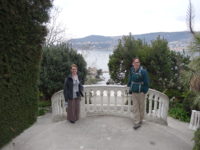 On vacation, you need to have transportation, even if it is just walking, which we have done a lot of. This vacation, we do not have a car, so we have spent a fair amount of getting to stations, waiting for trams and buses, then getting to where we are going, only to have to walk more. It is an okay way to get around, but when the more tech-savvy members of the group talked about using Uber to get a ride home the other night, it reminded me there are other ways. Sadly, Uber does not work for a group of six, so we are still bus-bound.
On vacation, you need to have transportation, even if it is just walking, which we have done a lot of. This vacation, we do not have a car, so we have spent a fair amount of getting to stations, waiting for trams and buses, then getting to where we are going, only to have to walk more. It is an okay way to get around, but when the more tech-savvy members of the group talked about using Uber to get a ride home the other night, it reminded me there are other ways. Sadly, Uber does not work for a group of six, so we are still bus-bound.
All of this by way of intro to getting out to Cap Ferrat, a small peninsula very near Nice. We left the hotel a little after 9:00, and after walking, riding a tram, walking, getting a bus, and walking, we finally made it to our destination on Cap Ferrat around 10:30 am; by car, it normally takes about 25 minutes. C’est la touriste!
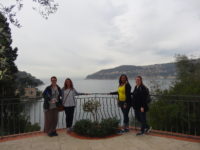 Where we got to was well worth it – the Villa Ephrussi de Rothschild. The villa was built by a wealthy daughter of a banker, and she bought seventeen acres of land on the high ground on the narrow neck of land out to the peninsula. Here, with views in all directions, she built a lavish villa and sculpted seven elaborate gardens in the early 1900s. When she died in the 1950s, she left the place to the French government as a public space.
Where we got to was well worth it – the Villa Ephrussi de Rothschild. The villa was built by a wealthy daughter of a banker, and she bought seventeen acres of land on the high ground on the narrow neck of land out to the peninsula. Here, with views in all directions, she built a lavish villa and sculpted seven elaborate gardens in the early 1900s. When she died in the 1950s, she left the place to the French government as a public space.
The house is impressive, with an indoor courtyard designed to look like an outside one. From it branch the main rooms – a couple of receiving rooms, a dining room, and Rothschild’s bedroom and bath. The upstairs had a viewing terrace, as well as more bedrooms. All the rooms had lots of windows for the views.
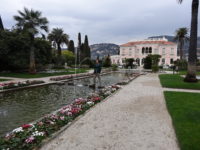 The gardens are amazing. The main garden directly behind the house includes a huge fountain that has choreographed water jets, set to classical music that plays every twenty minutes. We never heard the same music repeated while we were there, and the fountain was great fun to watch. Above the fountain was a Greek-style round temple, with a cascading stepped waterfall that fell into the main pool for the fountains.
The gardens are amazing. The main garden directly behind the house includes a huge fountain that has choreographed water jets, set to classical music that plays every twenty minutes. We never heard the same music repeated while we were there, and the fountain was great fun to watch. Above the fountain was a Greek-style round temple, with a cascading stepped waterfall that fell into the main pool for the fountains.
From the main garden, you could wander through six other gardens – a rose garden (not yet in bloom), a Japanese garden, a rock garden, a Florentine (Italian) garden, a Provencal (local) garden, an exotic plant garden, and a Spanish garden. Scattered throughout the gardens were sculptures and fountains. We were there sufficiently early enough that we often had rooms in the house or places in the gardens to ourselves. It was grand.
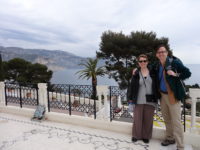 We finished up around 1:00, and decided to split the group again. Mer and I wanted to go to Eze-le-Village, where we had seen the ruined castle on a hill when we had gone by on the bus the day before. The others wanted to get back to the hotel to change into nice clothes and then go to Monaco to at least see the lobby of Monte Carlo and other parts of the town. We all rode the same bus partway back to Nice; Mer and I got off early in order to climb up to the middle Nice-Monaco road to catch a bus back to Eze. Turns out it was quite climb, involving a lot of stairs. We were not sad to sit for a bit before the bus came.
We finished up around 1:00, and decided to split the group again. Mer and I wanted to go to Eze-le-Village, where we had seen the ruined castle on a hill when we had gone by on the bus the day before. The others wanted to get back to the hotel to change into nice clothes and then go to Monaco to at least see the lobby of Monte Carlo and other parts of the town. We all rode the same bus partway back to Nice; Mer and I got off early in order to climb up to the middle Nice-Monaco road to catch a bus back to Eze. Turns out it was quite climb, involving a lot of stairs. We were not sad to sit for a bit before the bus came.
Eze is not very big – mostly some shops on a couple of streets leading up to the former castle. We grabbed a quick crepe and ate it while we sat on a bench before proceeding up to the castle. Much of the former castle has been turned into shops and restaurants, and even a high-end hotel (starting at 370 euros a night). It was fun to wind through really narrow streets, looking in shops crammed into rock-bound rooms. We made our way all the way up to the top of the castle, where we paid to get into the garden there.
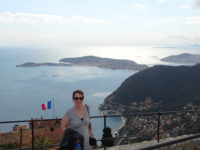 The views really were incredible. The mountains were on one side, and the sea on the other, and you could see in every direction. The gardens were well-laid out, with cactus on the sea side, and a Mediterranean garden on the land side. Sprinkled throughout were statues of semi-finished women, who all had different expressions on their faces; the less finished torsos seemed to suggest trunks of trees. It worked well for a garden.
The views really were incredible. The mountains were on one side, and the sea on the other, and you could see in every direction. The gardens were well-laid out, with cactus on the sea side, and a Mediterranean garden on the land side. Sprinkled throughout were statues of semi-finished women, who all had different expressions on their faces; the less finished torsos seemed to suggest trunks of trees. It worked well for a garden.
We explored the rest of the castle, including making it to the church and graveyard that are up on the hill. We found some really narrow back streets, and got to see into one very fancy room of the hotel when the door was left open. We walked back down to the main road, where we stopped at a bakery to get a snack and ask where the bus stop was.
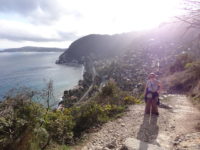
After thirty minutes of waiting for a bus, I decided this was a stupid waste of time. I thought it would be brilliant to walk down the Nietzsche Footpath, a steep and rugged 1.7-mile path down to the bigger Eze-Bord-du-Mer. What could go wrong? It seemed better than waiting for a stupid bus (which was going to be another thirty minutes before it came, if there was room to get on).
About seventy-five minutes later, after some rough footing, a few gasps of panic while slipping, and several astonishing views, we got to lower Eze. The Nietzche Footpath is not built for speed. Oh – it was named for Nietzche since he thought of the concepts for his book Thus Spoke Zarathustra while walking on the trail. How he could have thought of anything other than planting a firm foot, I’m not sure, but he managed.
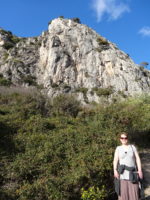 I had planned on getting the bus back to Cap Ferrat to eat supper and then walk around the coastline, but that had disappeared in a fog of fatigue. We took the bus back to Nice, and then rode the tram, before walking to a restaurant for supper. We got back to the hotel around 9:00, on foot, of course. The others seem to be still out on the town – I hope they are having a wonderful time in Monaco. They can at least get a train back to the station in Nice, which should make for an efficient and comfortable end of their evening.
I had planned on getting the bus back to Cap Ferrat to eat supper and then walk around the coastline, but that had disappeared in a fog of fatigue. We took the bus back to Nice, and then rode the tram, before walking to a restaurant for supper. We got back to the hotel around 9:00, on foot, of course. The others seem to be still out on the town – I hope they are having a wonderful time in Monaco. They can at least get a train back to the station in Nice, which should make for an efficient and comfortable end of their evening.